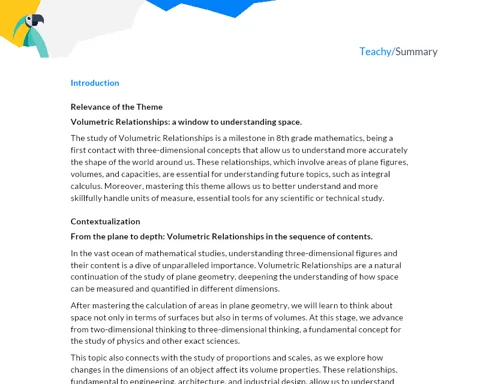Rounding | Active Summary
Objectives
1. 🎯 Understand and apply the concept of rounding to the nearest powers of 10, tens, hundreds, and units.
2. 🎯 Develop skills to solve everyday problems involving rounding, such as in shopping, measurements, and distance calculations.
3. 🎯 Learn the importance of rounding in practical situations and how it can facilitate quick and accurate decisions.
Contextualization
Did you know that rounding is an essential mathematical tool used in many modern technologies? For example, GPS systems use rounding to provide accurate directions, considering the distances between points of interest. Similarly, in measurement apps, such as for recipes or construction, rounding is crucial to ensure that quantities are adequate and easy to follow. These examples show how rounding is not just a theoretical concept but something that directly impacts our daily lives and the functioning of many technological innovations.
Important Topics
Rounding to Powers of 10
Rounding to the nearest power of 10 is a fundamental technique that helps us simplify large numbers and make them easier to work with. For example, if we have the number 389, rounding it to the nearest power of 10 would result in 400. This type of rounding is often used in estimation calculations and in solving problems that require more manageable numbers.
-
Identify the nearest power of 10: To round a number, it's essential to identify which power of 10 is closest to the original number.
-
Rounding rules: If the last digit that you want to keep is 5 or greater, the preceding digit should be rounded up to the next higher number; otherwise, the digit remains unchanged.
-
Practical applications: Rounding to the power of 10 is frequently used in budgets, project estimates, and in other situations that require quick and approximate calculations.
Rounding to Tens, Hundreds, and Units
In addition to rounding to powers of 10, it is common to round numbers to the nearest tens, hundreds, or units. This practice is extremely useful in contexts where we need less precision, such as in weight, distance, or time measurements. For example, rounding 78 to the nearest ten gives us 80.
-
Identify the place of interest digit: Depending on the desired type of rounding, it's crucial to focus on the correct digit to perform the rounding.
-
Decisions based on proximity: In practical situations, we often make rounding decisions based on the distance from the original number to the desired number.
-
Practical applications: This type of rounding is frequently applied in shopping, adjusting measurements, and in situations where precision to the unit is not critical.
Rounding to Other Powers
In some situations, it may be necessary to round numbers to powers that are not multiples of 10. For example, rounding to the nearest ten that is not a multiple of 10, such as 70 or 90. This is common in areas where numbers are particularly significant in a specific context, such as scores or ratings.
-
Identify specific rounding powers: Depending on the context, it may be necessary to round to powers that make more sense in a given situation.
-
Adjustments in calculations: This type of rounding often requires additional adjustments in subsequent calculations to maintain relative accuracy.
-
Special applications: Used in situations like test scores, where the rounded numbers should accurately reflect the individual's performance.
Key Terms
-
Rounding: The process of adjusting a number to a simpler value, usually the nearest multiple of 10, 100, etc.
-
Power of 10: A number that is the product of 10 raised to an integer, such as 10, 100, 1000, etc.
-
Digit of Interest: The digit in a number that we are interested in keeping or modifying during rounding.
To Reflect
-
How can rounding influence the accuracy of calculations in science and technology?
-
What is the importance of understanding different rounding methods in practical situations, such as personal finance or engineering?
-
In what ways can rounding simplify decision-making in everyday situations, such as shopping or event planning?
Important Conclusions
-
Today, we explored the fascinating world of rounding in mathematics, a crucial skill that not only simplifies large numbers but also makes life easier in many practical situations.
-
We learned to round to the nearest powers of 10, tens, hundreds, and units, and how these techniques are applied in contexts like shopping, measurements, and distance calculations.
-
We discussed real-world examples where rounding is essential, such as in modern technologies and everyday situations, showcasing the relevance and applicability of this knowledge.
To Exercise Knowledge
- Supermarket Calculation: Make a shopping list for a week and round the prices of items to the nearest ten. Calculate the total cost before and after rounding. 2. Distance Measurement: Measure the distance from your home to a frequent location (like school) and round the distance to the nearest hundred. Compare how rounding affects the perception of distance. 3. Time Management: Write down the start and end times of your daily activities and round the times to the nearest ten. Reflect on how rounding can help plan your day better.
Challenge
🌟 Junior Astronomer Challenge: Using an astronomy app or a reliable website, find the distance from Earth to Mars on a specific day and round that number to the nearest ten. Try doing this for a different week and compare how rounding affects the perception of distances in space.
Study Tips
-
Practice rounding with large and small numbers to gain fluency and confidence. Use online games or math apps to make learning more fun.
-
Try applying rounding in different situations in your daily life, such as in board games involving scores or when calculating tips in a restaurant.
-
Discuss with your peers the rounding strategies each person uses and how they may vary depending on the situation's context. This can help enhance your understanding and application of the concept.



